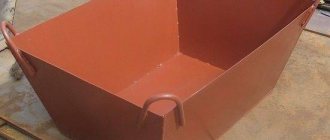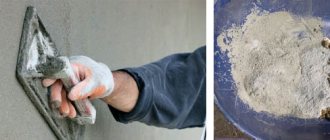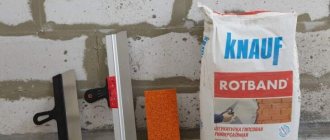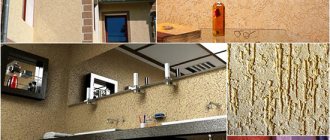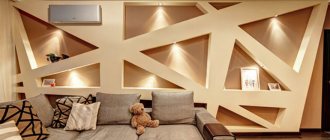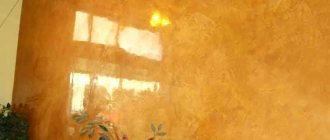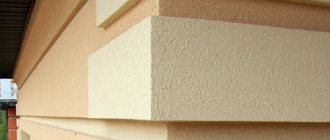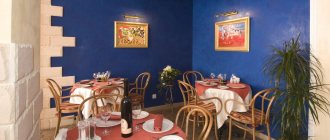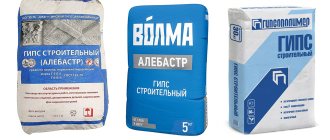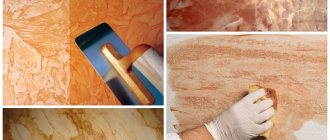Decorative plaster is a general name for a group of building materials that are used for finishing surfaces indoors or outdoors. As the name implies, such compositions are used only for decorating walls and ceilings. Of course, they can also be used to level walls, but due to the relatively high cost, it is better to use them for their intended purpose. Before starting finishing work, you need to find out the consumption of decorative plasters per 1 m2 in order to buy the required amount of the mixture.
Textured solutions
Such mixtures are used to create coatings that imitate the texture of natural stone, leather, wood and other textures. This type of plaster boasts one of the lowest costs, which ranges from 0.9 to 1.5 kg per square meter. To calculate more accurately, you must first determine the grain size of the solution. If it contains fine components (about 1 mm), then the consumption will be minimal, since the thickness of the layer must correspond to the grain size in the mixture. If the grains reach 2-3 mm, then approximately 1.2 kg of textured mixture per square meter will be required. For coarse-grained materials, the consumption of decorative plaster increases to 1.5 kg.
Decorative plaster imitating the texture of wood, characterized by low material consumption
For example, we have a wall with an area of 10 square meters. m, which needs to be covered with a textured solution of medium dispersion in two layers. We multiply the size of the wall area by the material consumption, and then by the number of layers, we get: 10x1.2x2= 24 kg. This is exactly how much textured plaster will be needed to treat the surface of a given area.
Important! The thickness of the total textured layer should not exceed 1 cm, that is, if a material with coarse grains is used, then a maximum of two layers can be applied.
The thickness of the plaster layer directly depends on the source material
Calculation rules
To calculate the required amount of mixture you will need:
- calculate the thickness of the applied layer;
- clean the wall from dirt and dust;
- install beacons along the entire plane of the wall being treated;
- select several points on the wall, using them you can check the deviation from a given plane. The more points are selected, the more accurate the final calculation result will be. Experts generally select three points to measure deviations;
- measure deviations from a given plane, summarize the results of deviations and divide by the number of selected points.
To make the methodology more understandable, let's carry out all the necessary calculations in practice.
Consumption of structural compositions
Structural plaster is a finishing material that can be made based on acrylic resins, cement or gypsum. Flour or natural stone chips are used as filler. The main feature is that after the material dries, a surface with deep relief patterns is formed. As for consumption, it depends on the composition of the finishing material:
Relief pattern of structural plaster
- Solutions with quartz chips are consumed in the same way as textured ones, since the thickness of the layer must correspond to the size of the filler fraction. If the solution contains grains up to 2 mm in size, then the consumption will be about 2 kg per square meter; if the grain diameter is 2-3 mm, then 2.5-3 kg will be required to treat 1 m2 of surface. Typically, such mixtures are supplied in 25 kg bags, so for a wall of 10 sq. m will need 1-2 bags, depending on the fraction.
- Materials that are made on the basis of acrylic resin dispersions are a homogeneous paste interspersed with small grains up to 2 mm. The plaster is supplied ready-made, so its consumption is higher: for a 1 mm fraction - 2.5 kg per 1 m2, for a 2 mm grain - 3 kg per square meter. m. Typically, such compositions are supplied in plastic containers of 15 kg. For a wall of 10 sq. m. you will need two such containers, provided that one layer is applied.
- Also quite popular are structural plasters based on marble chips or mixtures of marble and granite, quartz, malachite and other natural stones. Such compositions can be applied in a layer of 1 to 3 mm, depending on the desired depth of texture. Material consumption per 1 square meter of treated surface with a layer thickness of 1 mm will be 1 kg. For processing one wall of 10 square meters. m is enough for one bag of material (25 kg). If you plan to apply two layers, it is better to purchase 2 bags.
- Another common type of structural plasters are materials based on synthetic acrylic resins. Most often they are used for finishing fireplaces, stoves and other surfaces that are exposed to high temperatures. Material consumption also depends on the filler fraction: 0.7-1 mm – 1.5 kg, 1.2-1.5 mm – 2 kg, 2-2.5 mm – 2.5 kg. The solution is supplied in 15 kg containers, so to finish a wall of 10 square meters. m will require 1-2 containers, depending on the size of the fraction.
What criteria need to be taken into account?
The amount of mixture is influenced by the following conditions:
- defective places on the surface. The direct costs of the solution used for plastering depend on them. In new buildings, the unevenness of the walls is sometimes several tens of millimeters; old surfaces can be terribly curved. It should be noted that strong curvature is first eliminated with a simple plaster solution, after which a decorative composition is applied.
- material of the wall surface to be repaired. The consumption of the mixture differs significantly when working on brickwork, gypsum board or concrete, or wood;
- type of solution. Its final volume depends on the type of material chosen. For example, the consumption of Venetian plaster per 1 m² is different from the need for the bark beetle material.
As a rule, the manufacturer specifies the required amount of decorative mortar per unit of area on the packaging container. Venetian is consumed at the rate of 140 g per square, the amount of “bark beetle” reaches 3 kg for a similar area.
Bark beetle plaster consumption
Decorative bark beetle plaster belongs to the structural category, but it has gained such popularity that it is worth talking about it separately. The consumption of bark beetle plaster varies from 2.4 to 4 kg per 1m2. This discrepancy is explained by the different grain sizes that are used for manufacturing, as well as the thickness of the layer. To determine the amount of solution that will be required for finishing work, it is recommended to consult with the salesperson in the store, and also read information from the manufacturer.
The consumption of bark beetle plaster depends on the grain fraction of the filler
You should know! After the calculation, you need to add 10% of the reserve, which will be needed if the plaster dries out or falls out of the container during work.
Also, the consumption of this material depends on the characteristics of production, namely, on the amount of water in the solution. For example, bark beetle plaster from the manufacturer Volma requires 6 kg per 1 square meter with a layer thickness of 1 cm. At the same time, the consumption of bark beetle under the Starateli brand is 9 kg per square meter. At first glance, the difference is not that big, but if you consider that the material is supplied in 25 kg bags, then to plaster a wall of 10 m2 you will need 3 bags of Volma bark beetle plaster and 4 from Starateli. Total: the difference is 1 bag for one layer, respectively, with 2 layers the difference will be 2 bags, and if we take into account four walls in the room, then the difference for finishing one room is 8 bags. In addition, the consumption per 1 m2 of finished materials and dry mixtures of bark beetles is also very different.
Ready-made bark beetle plaster solution
Let's sum it up
In general, calculating the required amount of decorative plaster is a fairly simple task. Pay special attention to collecting indicators, since if even the slightest mistake is made, all calculations will be incorrect. For a decorative mixture, a flat surface is extremely important, so if the wall defects are too large, you will need to carry out additional plastering of the surface with a regular solution without a decorative effect. Remember that all calculations must be carried out before going to the store. Pay special attention to the manufacturer's recommendations on the packaging, because the required amount of solution will be indicated there. We recommend watching a training video in which you can see in practice the process of measurements and calculations:
Recommended Posts
Decorative plaster Parade
Decorative plaster Oikos
Decorative plaster for walls Bayramiks
Which sand is best for plastering walls?
Reinforcing mesh for plastering walls: metal, plastic…
Why does plaster crack when drying?
Venetian plaster consumption
Venetian plaster is a very popular type of decorative finishing materials. With its help, they create coatings that imitate natural marble with its shine and tints of color. This solution has the lowest consumption among other plasters. But this attractive indicator is achieved due to the ideal leveling of the surface, which, coupled with the cost of work and the prices of the Venetian itself, makes this type of coating the most expensive. The consumption of such material ranges from 70 to 200 grams per 1 m2.
Venetian plaster has the lowest consumption among other decorative mixtures
Since the walls are perfectly smooth, the thickness of the layer, and accordingly the required amount of composition, depends only on the desired effect. The greater the depth of color the customer wants to achieve, the more solution will be required per square meter.
Use of material
Marble.
plastering house facades Marble plaster is currently one of the best materials for external finishing of building facades.
Excellent strength and excellent moisture resistance make it easy to use this finish for external work.
The high adhesion of this material allows it to be easily applied to various substrates - brick and block walls, reinforced concrete panels, plasterboard, chipboard, wood, surfaces coated with acrylic and water-based paints.
High-quality marble plaster is an independent finishing material that does not require any further treatment of the walls. This coating has a refined, original appearance.
Therefore, if you are bored with the classic options for decorating a room with ceramic tiles and wallpaper, then this marble-based finish will be the best option for you.
How to reduce the consumption of decorative plasters
The prices for this material are not very high, but if you take into account the entire volume of necessary solutions and the cost of finishing work, you can get a fairly large amount. Therefore, it is recommended to follow simple rules that will help you save a little and reduce material consumption per m2:
- Use cheap cement-based mixtures for rough work.
- During the initial finishing, try to level the surface as much as possible so that the walls are covered no more than 5 mm.
- If the walls have significant curvature, it is more advisable to use plasterboard slabs to level the surface.
- Use primers that are recommended by plastering manufacturers, even if they are expensive.
Planning repair work is one of the most important stages of this event. A correctly calculated amount of material, as well as the selection of suitable consumables, will protect the customer from possible deception on the part of workers and the need to purchase additional solution during finishing.
Important Rules
Before moving on to calculations, determine the area of the walls to be repaired. To this end, check their length and height parameters in increments of one meter to eliminate possible unevenness. If you are going to finish in fragments, take into account only the areas intended for processing, determine the area of each, and add up all the values.
To find the total area, multiply the length by the height.
The plaster consumption is determined by multiplying the area of the wall surface being repaired by the norm for a meter area indicated by the manufacturer on the packaging container. If a thick layer is to be applied, additional calculation steps are performed.
A ten percent supply of material is added to the final data, taking into account possible losses.
So, to perform the calculations you need to clarify:
- surface parameters;
- the height of the mortar layer to be applied;
- type and brand of solution;
- mass of material in one package.
For the convenience of performing calculations, it is recommended to use an online calculator by entering known data into the appropriate columns.
How to calculate the dimensions of walls and ceilings
To do this, you just have to remember your favorite school and geometry lessons. It is known that the area of a rectangle is its length multiplied by its width. The area of window and door openings, as well as places where plastering is not required, is taken from the result obtained.
For example, it is planned to renovate a room 3 meters wide, 4 meters long, let the ceiling height be 2.8 meters. The room has a window measuring one and a half meters by one meter and a door measuring two by one meter. Let's calculate the area (S) of the walls:
- S long wall 4 m X 2.8 m = 11.2 m2
- S short wall 3 m X 2.8 m = 8.4 m2
- Total S of all four walls 11.2 m2 X 2 + 8.4 m2 X 2 = 39.2 m2
- S window opening 1.5 m X 1 m = 1.5 m2
- S doorway 2 m X 1 m = 2 m2
- Total S openings 1.5 m2 + 2 m2 = 3.5 m2
- S wall plaster 39.2 m2 - 3.5 m2 = 35.7 m2
- Ceiling S will be 3 m X 4 m = 12 m2
In this case, we will separately calculate S of the ceiling, which will be 3 m X 4 m = 12 m2. Why do we count the ceiling area separately? Plastering the ceiling is a rather specific and not as popular service as plastering the walls. Plus, work on ceilings costs more than work on walls.
If you have an unusually shaped room, calculating the area will be a little more difficult. You may need to remember the formulas for the area of a triangle, circumference, etc. To simplify the task, special programs are used - plaster area calculators. This application can be installed on your phone, tablet or computer.
Calculation method
The consumption of facade plaster per 1m2 or mortar for interior decoration can be calculated using a certain algorithm. The following actions are performed:
- first of all, thoroughly clean the area of the base intended for plastering;
- to determine the degree of curvature, place beacons (a minimum number of 3 pieces per face) on the wall using a regular or laser level;
- indicate key points, from which the deviation of the outer surfaces of the base from the plane is further determined;
- carry out measurements of deviations from the desired plane;
- balance the numbers;
- divide the result by the number of key points.
If you don’t particularly want to carry out calculations, you can use a special calculator to calculate the plaster consumption. In this case, the following parameters must be entered:
- wall parameters: height and length;
- average thickness of the plaster coating;
- type of composition used;
- weight of 1 package (bag).
The result of the calculations carried out by the calculator will be the required number of bags of material so that the plaster consumption is optimal during operation.
